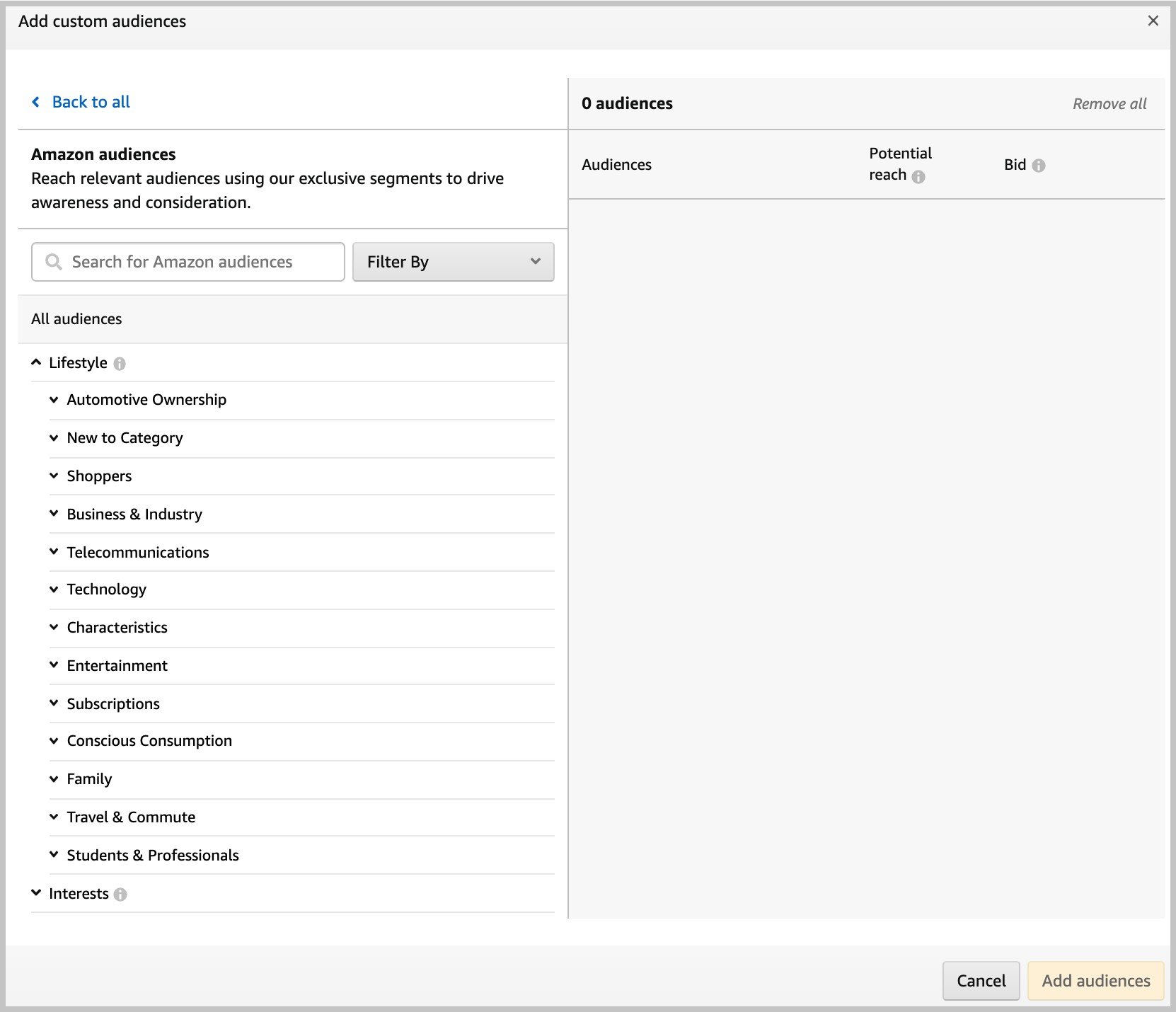Amazon Sponsored Display lets advertisers engage buyers at the top of the shopping funnel using display ads on Amazon, across the web, and in apps. And now, Amazon has added more options to Sponsored Display with new audience types.
In this post, I give a high-level overview of Amazon Sponsored Display, the new audiences, and the opportunities the audiences create for eCommerce advertisers.
What Is Amazon Sponsored Display Advertising?
Amazon Sponsored Display is mostly what it sounds like — display advertising. It’s one of the three Amazon Advertising options:
- Sponsored Products
- Sponsored Brands
- Sponsored Display, which is different from Amazon DSP
Each has its benefit and use. And all three are great when used together.
Sponsored Products and Sponsored Brands run only on Amazon.com though. Amazon Sponsored Display ads are shown on the home page product detail pages, and shopping results pages of Amazon.com and off Amazon.
 The term, Amazon Sponsored Display, really refers to the software-as-a-service tool that advertisers use to create and manage their display ads.
The term, Amazon Sponsored Display, really refers to the software-as-a-service tool that advertisers use to create and manage their display ads.
The creative for Amazon Sponsored Display ads is automatically created but also limited. The ads essentially pull your product image and product title into an ad. You can add a custom headline if you want. The ads always link to your product detail page.
Currently, Sponsored Display ads are available to Amazon Sellers and Amazon Vendors in Canada, Germany, France, India, Italy, Japan, Spain, the United Arab Emirates, the United Kingdom, and the United States. Ads in India and Japan are limited to Amazon.com and not available off Amazon.
The Benefits of Sponsored Display Advertising
Sponsored Display has some nice features that work really well for Amazon Vendors and Sellers, including:
- Creating display ads for you using your existing Amazon assets.
- Automatically running ads only when your products are in stock.
- Charging you only when the ad is clicked with a cost-per-click (CPC) model.
- Letting you set your own budget and bid thresholds.
The key benefits of Amazon Sponsored Display ads are for brand awareness and growth on and off Amazon. You can use them to drive traffic for your product pages while cost-effectively growing revenue at a good advertising cost of sales (ACoS).
It’s a useful tool for brands that are new or not as well known as their competitors. It’s also valuable for creating awareness of new products and categories.
A Sponsored Display Ad for Ankerkraut on a competitor’s product page.
Targeting Options with Amazon Sponsored Display
Amazon Sponsored Display ads can be targeted by product or audience.
Product targeting options included — and still include — entire product categories or individual products.
Previous retargeting audiences included views remarketing, which let Sellers and Vendors retarget shoppers who’d look at, but not purchased, the seller’s products or similar products in the last 30 days.
Now, Amazon has added new, specific audience options for Sponsored Display. The audiences are available to both Sellers and Vendors and include audiences in the following four main categories:
- In-market, which includes shoppers who’ve recently shopped given product categories, including your own category, related categories, or entirely different ones.
- Interests, which shows ads to shoppers based on their browsing and buying habits.
- Lifestyle, which, per Amazon, includes shoppers based on “a variety of aggregated shopping and viewing behaviors.”
- Life events, which are based on “life moments.”
Note Amazon Vendors in India and Japan are limited to Interests audiences only.
The Lifestyle audiences available in Amazon Sponsored Display.
What Are In-Market Audiences?
In-market audiences are not new to paid advertising. Google Ads has offered in-market audiences for some time. Google describes in-market audiences as those that, “allow you to find customers who are researching products or services and actively considering buying something like what you offer as they browse pages across the web.”
An example Google gives of an in-market audience is “Furniture.”
Google creates its in-market audience based on users’ browsing behavior. Its algorithms might determine that the user, based on her browsing, is in the market to buy a chair. Advertisers running ads on Google Ads can then target the buyer with ads for chairs.
In-market audiences in Sponsored Display offer the same functionality. And Amazon advertisers can also target Sponsored Display ads by price, customer rating, and Amazon Prime eligibility.
The Power of the New Audiences for Amazon Sponsored Display
Amazon introduced the new audiences to Amazon Sponsored Display in mid-April.
The power of the audiences, especially the in-market audiences, is stronger on Amazon than Google.
Google Chrome is the world’s most popular search engine with 62.98% of the browser market share. It is though, a search engine. Yes, people search for products when in the market to buy using Google Chrome. But they also search for product when researching to buy or just for fun or any other reason.
People, however, go to Amazon to shop for the most part. Even if researching products, there’s a strong likelihood that the intent is to buy that product or a similar product in the near-term
Amazon Audiences Are Ready to Buy
I’ll use myself as an example to illustrate the power of Amazon Sponsored Display audiences versus a potential weakness in Google audiences.
I’m a huge sports fan. I read a lot about soccer and sports. So Google would naturally put me into an affinity or interest audience for soccer. I never buy soccer items or jerseys from any sports team. But because Google puts me in that affinity audience, advertisers will pay money for me to see their products.
But on Amazon, if I’m looking for sports stuff, Amazon knows I’m interested in buying something sport-related. Amazon is at an advantage with its audiences because it’s strictly a marketplace and not a search engine. They can target their audiences much more specifically than any other platform can.
Amazon, like any ad platform, doesn’t reveal the data it collects and uses to build its audiences, but given the amount of data it has on shoppers, the possibilities of empowering advertisers to target shoppers is immense.
This for me is the power of these new audiences.
Use Cases for the New Amazon Audiences
I’ve already used the new audiences for Finch clients using Amazon Sponsored Display. For one client who sells floatable sunglasses, I used the in-market audience for water sports. That audience gives me confidence that the shoppers who see the ad are currently browsing for water sports.
Another option is someone going on a vacation soon.
I used a lifestyle event audience for a furniture eTailer by choosing the audience for people who moved in the last four weeks. That’s, of course, according to Amazon’s data. Amazon likely knows that because the user changed his/her address or recently bought items consistent with moving.
Another potential use case is if you’re selling pet products and have a fun new toy for pets. Your product is unique enough that no one really searches for it. With the new audience options, you could target pet owners searching for pet toys. Anyone seeing your ad sees your product that they didn’t know about or even know to search for.
Being able to target those audiences where a product fits virtually perfectly is a big change — a powerful change.
Try Amazon Sponsored Display and the New Audiences
If you’re interested in expanding your reach using Amazon Sponsored Display or if you use it already, try the new audiences out. They offer exciting possibilities for reach and growth.
If you’re looking for strategic help and/or help implementing your Amazon Advertising or other ad platform strategy, contact Finch. Finch helps eCommerce companies around the globe easily and scalably grow awareness and revenue across channels and platforms, including Amazon.







